$1,100 Direct Deposit Checks In June 2025: Many Americans are hopeful about upcoming financial support from the federal government. One such initiative making headlines is the $1,100 Direct Deposit Checks 2025. With inflation and economic pressure continuing to impact low-income households, timely financial assistance can make a significant difference. The IRS is expected to distribute these payments to eligible individuals, especially those who filed their taxes on time and fall within specific income limits.
Although the initiative is not officially confirmed as a recurring program, several reports suggest that direct deposit refunds and relief payments amounting to $1,100 may be processed for qualifying citizens in June 2025. Understanding the eligibility, timelines, and process is crucial to ensure you don’t miss out on this benefit.
$1,100 Direct Deposit Checks 2025
The $1,100 Direct Deposit Checks 2025 are expected to benefit low-income families, elderly individuals, and those with disabilities. These payments aim to provide financial stability by supporting citizens with basic expenses and tax refund assistance. The IRS handles the distribution process through direct deposit or mailed checks based on how taxpayers filed their returns.
Overview Table- $1,100 Direct Deposit Checks 2025
| Detail | Information |
| Program Name | $1,100 Direct Deposit Checks 2025 |
| Amount | $1,100 |
| Issued By | US Federal Government through the IRS |
| Eligibility Criteria | Filed tax returns, U.S. resident, valid Social Security number |
| Target Group | Low-income earners, elderly, disabled individuals |
| Application Requirement | Tax filing and valid SSN |
| Deposit Method | Direct bank deposit or paper check |
| Official Website | www.irs.gov |
$1,100 Direct Deposit Eligibility 2025
To receive the $1,100 direct deposit in 2025, individuals must fulfill certain eligibility conditions outlined by the IRS. These include:
- You must be a U.S. resident.
- You must have filed your taxes for the year 2024 by the required deadline.
- A valid Social Security Number (SSN) is mandatory.
- Income must fall within the low to moderate range, as set by federal guidelines.
- If filing electronically, refunds may be processed and received within 21 days.
- If filing by mail, expect potential delays in receiving your check.
These criteria help ensure that only eligible taxpayers who are in genuine need receive the benefits.
$1,100 Tax Refund Deposit Dates 2025
Here are the expected IRS refund payment dates based on when income was earned and taxes filed:
| Income Earned Period | Estimated Refund Date |
| January 1 – March 31, 2025 | June 15, 2025 |
| June 1 – June 30, 2025 | July 17, 2025 |
| July 1 – August , 2025 | September 16, 2025 |
| September 1 – December 31, 2025 | January 15, 2026 |
Filing taxes early and opting for direct deposit is the fastest way to receive your refund.
How to Claim $1,100 Direct Deposit Checks In June 2025
If you’re eligible and have filed your taxes, claiming the $1,100 direct deposit is a straightforward process. Follow these steps:
- Visit the IRS Website: Go to www.irs.gov.
- Log into your account or create one using your SSN and personal details.
- Fill out the tax return form if not already done, and ensure all income details are accurately provided.
- Submit the return electronically for faster processing.
- Attach supporting documents, such as income statements or proof of identity if requested.
- Choose Direct Deposit: Provide your bank account details to ensure quicker refunds.
- Wait for confirmation: The IRS will notify you once your refund is approved.
Understanding the IRS Refund Timeline
Depending on how you file and choose to receive your refund, processing times can vary:
| Filing Method | Refund Timeline |
| File + Direct Deposit | 1–3 Weeks |
| File + Paper Check | Up to 1 Month |
| Direct Deposit + Mailed Return | Around 3 Weeks |
| Mailed Return + Paper Check | Up to 2 Months |
To avoid delays, always opt for electronic filing and direct deposit.
$1,100 Direct Deposit Checks 2025: Fact Check
Let’s clear up the confusion surrounding this initiative:
- Claim: Every eligible taxpayer will receive a $1,100 check in June 2025.
- Fact: While reports suggest IRS is issuing $1,100 refunds, these are primarily tax refund payments and not part of a special stimulus or guaranteed payment. They depend on individual tax status, income level, and filing date.
- Conclusion: The $1,100 checks may be real for eligible taxpayers but are not universally guaranteed payments.
Always refer to official IRS updates to confirm whether you qualify.
Benefits for Low-Income Families and Seniors
If you don’t qualify for the $1,100 payment, there may be other benefits available:
- SSI and SSDI: Monthly payments to disabled and elderly individuals with limited income.
- SNAP and Home Energy Assistance: Extra support to help cover food and utility costs.
- Other Tax Refunds: Some individuals may qualify for additional refunds depending on their 2024 income tax returns.
Check www.irs.gov for the latest updates on all federal support programs.
FAQs
1. What is the best way to receive the $1,100 payment quickly?
Filing taxes electronically and selecting direct deposit can ensure you receive your refund within 21 days.
2. Who qualifies for the $1,100 direct deposit check?
U.S. citizens with low to moderate income who have filed their 2024 taxes on time are likely to qualify.
3. How will I know if I am getting the refund?
You can check your refund status on the IRS website using the “Where’s My Refund?” tool.
4. What happens if I file by mail?
Mail-in tax returns take longer to process. Your refund may be delayed by several weeks.
5. Is this $1,100 check the same as a stimulus check?
No, this appears to be part of IRS tax refund programs, not a COVID-related stimulus initiative.
Conclusion
The $1,100 Direct Deposit Checks 2025 offer timely financial relief to those who qualify. While not officially labeled as a stimulus payment, this IRS tax refund can provide essential support to low-income earners, retirees, and disabled citizens.
















